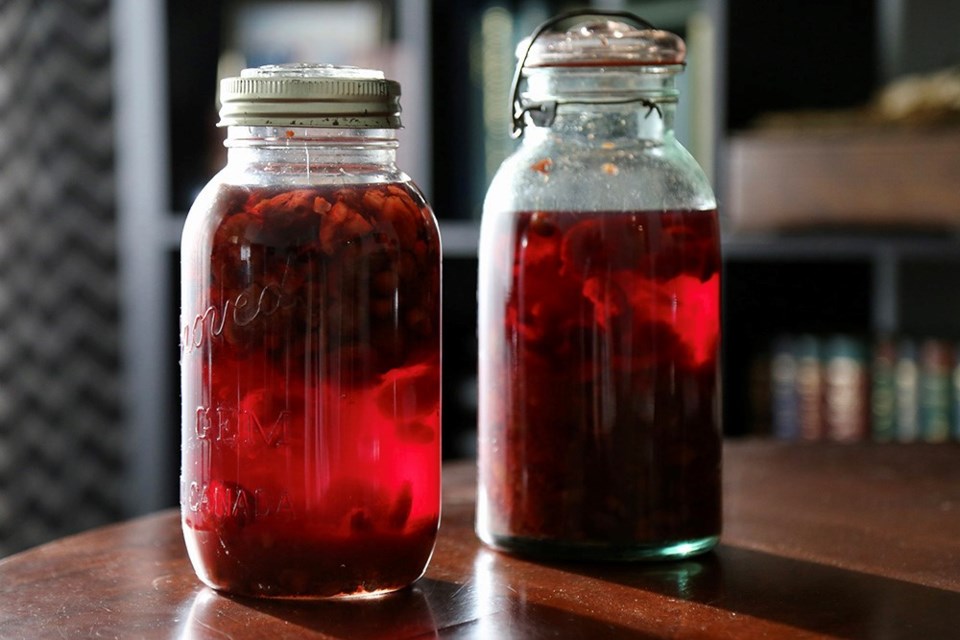Fruity infusions may encourage family and friends to stay hopeful and close to home.
We don’t have a choice, really, with post-storm gasoline rationing, travel restrictions, and cold monsoon-like rain, we could do worse than curl up in front of the fire with a glass of something bright and summery to warm our cockles.
Like our family, many of our friends are implementing gift-giving guidelines, encouraging home-made, vintage, recycled/upcycled and sustainable/renewable choices over mass-produced "stuff."
With very few exceptions, I am gifting from our garden and kitchen this holiday season. Those gifts are looking a bit different than anticipated, due to the heat waves. Nonetheless, they will be beautiful, delicious and spirited — representative of the hope and resilience needed to navigate climate change.
Since the element of time is an ingredient in most recipes involving steeping in or infusing alcohol, late November represents my last call to make spirits and spirit-based gifts for Christmas and holiday gifting.
Now is the perfect time to make creative use of the sweet and delicious frozen spoils of summer — those lovely ripe fruits that came into season far too quickly to preserve alongside everything else, and were instead stowed away in the freezer for a rainy day.
Typically, I have containers full of blueberries, cherries, plums, figs, huckleberries and sometimes strawberries frozen for merry making and winter consumption, but this year I have only gooseberries, red and white currants, jostaberries, plus a few Italian plums from friends.
We lost our blueberries, figs, plums, cherries and huckleberries during the heat waves. We did salvage some gooseberries and jostaberries, though they fell to the ground before fully ripening. I harvested the currants between heat waves one and two, just in case.
We froze some of the currants and dehydrated the gooseberries, hoping to concentrate the small amounts of sugar that were on-board at that point.
I did not make traditional damson plum gin this year, choosing instead to "pioneer" a fruit liqueur, using what I have on-hand in the freezer and pantry, and a generalized recipe based on tasting as I go. In a perfect world, I would be organized enough to allow for the prescribed 12-week steeping period, but "it’s been a year" as they say, and I’m happy enough to have the four or five weeks that I know instinctively will be plenty enough.
I reconstituted the dried gooseberries and jostaberries in a small amount of water, heating gently in a saucepan until the berries plumped up. I added the berries and liquid to an amount (see proportions below) of crushed frozen red and white currants — mostly white as our veggie dog Dave preferred the red ones — and I’m steeping the lot in gin for three weeks or so before adding sugar in stages.
Easy peasy — a work-with-what-you-have sort of guideline for spirited gifting. An actual guideline for first-timers making damson, blueberry, cherry, or other fruit-infused gin (or vodka) would go something like this:
Damson Gin
Ingredients:
1 lb. (454 g) damson (or other) plums
1/2 lb. (225 g) white sugar (or honey or maple syrup to taste)
1 26 oz. (750 ml) bottle gin
Method:
Freeze dry damsons overnight, ensuring that they don’t stick together.
Cover the frozen fruit in a clean kitchen towel and then using a meat tenderizer or other heavy flat-bottomed object, crack the damsons open and add them, pits and all, to a large glass jar.
Pour over the gin and give it all a stir to break apart any clumps and expose as much fruit flesh as possible.
Cover and leave in a coolish spot to ruminate for eight to 12 weeks ideally (four or five works if need be). Check regularly to ensure that the fruit is submerged, and stir when you do.
About two weeks before bottling, add half of the sugar, stirring to dissolve, and then taste. Add remaining sugar to taste if needed; stirring and resting until clear.
Strain the mixture through two layers of dense clean cotton set into a sieve.
Pour into pretty jars or decanters sourced from thrift shops, and label as desired.
Laura Marie Neubert is a West Vancouver-based urban permaculture designer. Follow her on Instagram @upfrontandbeautiful, learn more about permaculture by visiting her Upfront & Beautiful website or email your questions to her here.
For a taste of permaculture, click on the YouTube link below:
(Video - Courtesy of West Vancouver Memorial Library)


